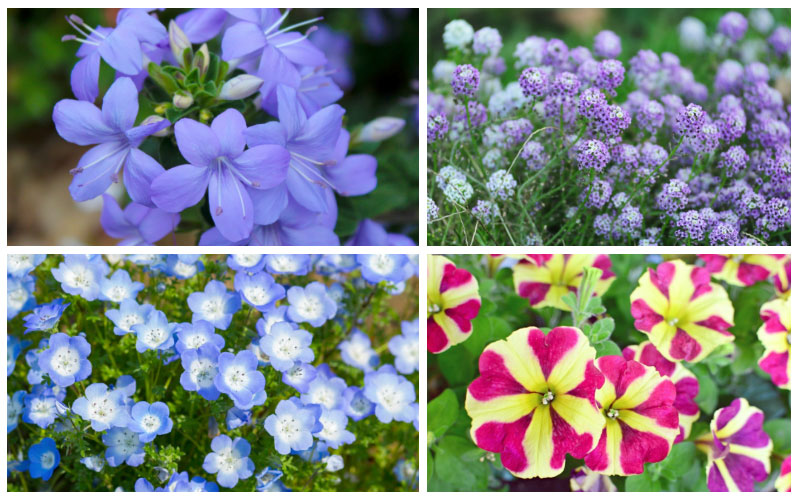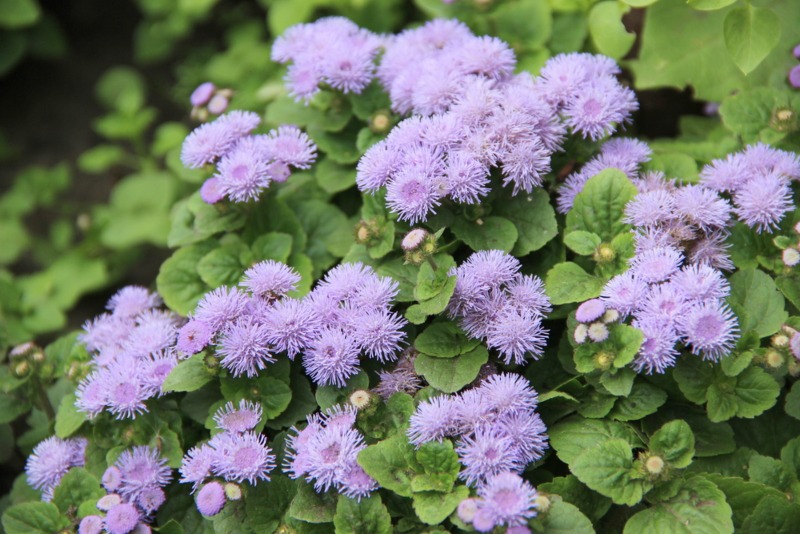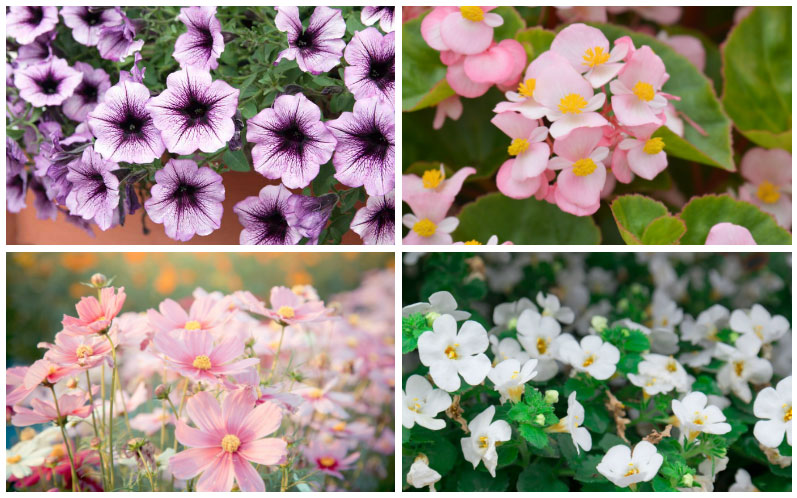
You can still grow beautiful plants even if you have obstacles in your garden that block full exposure to the sun. Trees, buildings, and fences will deprive some of your garden plants of continuous access to the sunlight. Luckily, there are lots of eye-catching annuals that add vibrant colors and life to your garden and can perfectly survive in partial shade.
Which Annuals Can Grow in Partial Shade?
If you have a shady garden or backyard, you can still grow beautiful and colorful flowers; not just foliage. These annuals won’t come back year after year, but they turn the shadiest corner of your backyard or garden to a feast of color.
1. Impatiens Divine Lavender

These annuals are easy to grow in partial or full shade. They’re grown in zones 2 to 11, although they’re treated as perennials in hardiness zones 10 and 11.
The lavender flowers bloom in late spring and provide a vibrant display throughout summer till fall. They make great bouquet flowers as the petals contrast beautifully with the dark green leaves.
2. Lathyrus Odoratus Clotted Cream Sweet Pea

Sweet peas love partial shade and prefer cool soils with good air ventilation. They bloom best in cool climates but they can be planted in hardiness zones 2 through 11.
Deadheading is necessary to promote new growth. The flowers start blooming in late spring and can remain till fall. Sweet peas attract butterflies and bees but they’re not edible.
3. Petunia Easy Wave Burgundy Star

This annual flower grows in hardiness zones 2 to 11 but is treated as a perennial in zone 11. It will bloom from late spring until the first frost covering a large area in your garden or cascading from baskets.
Petunias attract hummingbirds and butterflies. But you should keep an eye on slugs and snails to make sure that they last for long. See our list of different varieties of Petunias here.
4. Lobelia

Lobelias are easy to grow and come in several vibrant shades, although the violet-blue ones are the most common. They grow in hardiness zones 4 to 8.
Lobelia Inflata is also known as Indian tobacco because Native Americans used to smoke it to treat asthma. These summer bloomers require little maintenance.
5. Torenia Summer Wave

Summer Wave is a trailing herb that grows all summer in zones 9 to 11. The flower has purple tube-like petals.
Also known as the Wishbone Flower, this amazing plant loves the sun but prefers some shade, especially in the afternoon. The flowers bloom from spring till fall and can be grown in baskets to add a special effect to your backyard or garden.
6. Browallia

This plant grows in zones 9 and 10 as a warm-weather annual. It usually reaches a height of 2 feet and grows purple-blue flowers with small white centers.
It best grows away from the direct sunlight and can be grown in containers and baskets. The Sapphire Flower blooms from spring until the end of summer and will attract hummingbirds.
7. Balsam

Growing what is known as the Touch-Me-Not flower; this annual grows in zones 2 through 11 and starts blooming from summer till fall.
The cup-shaped flowers are red, pink, purple or white and have explosive seed discharge once the pods are ripe. Just pinch the pod and collect the seeds for the next growing season.
8. Nemesia

Nemesia flowers look a lot like orchids. The Nemesia Strumosa is popular annual bedding that produces a dense carpet of bright flowers which can hide the foliage completely, especially when grown in mild temperatures.
The flowers bloom in the summer and can be red, orange, yellow, pink, mauve, blue or white. Nemesia varieties grow in zones 2 through 11 and some of them are bi-color. The flower needs protection, especially from the afternoon sun.
9. Bacopa

This trailing annual grows little flowers from June through October. The flowers are white, pink, lavender, blue, red or coral.
Bacopa grows beautifully in zones 9 through 11 where shade is provided from the afternoon sun. It should be well-watered and can be grown in containers as well.
10. Blue Ageratum

The blue floss flower blooms from mid-summer till fall. Other kinds have petals that can be purple, blue, pink, red, white or bicolor. Ageratum prefers light shade, especially in hot summers. It grows in zones 2 through 12.
Overhead watering can cause mildew, so you should make sure that the soil is well-ventilated. The taller versions make great cut flowers. The distinctive blue color makes this flower so popular.
11. Hippo Rose Polka Dot Plant

If you’re living in zone 10 or 11, you should consider adding Hippo Rose Polka Dot plant to your garden. The extraordinary color of the foliage is the main reason why this plant is so popular.
It’s heat-tolerant and low-maintenance so you can easily grow it in pots. Although this plant has no flowers, the stunning green leaves show splashes of pink, red, rose or white.
12. Sweet Alyssum Flowers

The Sweet Alyssum flowers are members of the Lobularia family. They can grow in rock gardens tolerating drought and dry soil. The Sweet Alyssum flowers grow in zones 2 through 11 but are considered as annuals in zones cooler than 9.
These flowers are loved by butterflies and are resistant to deer. They have a long blooming season from late spring to frost. The flowers are usually pale pink or purple.
13. California Bluebells

These stunning cobalt blue flowers have triangular leaves. They love the shade, especially if the soil has good drainage.
The flowers grow in zones 1 through 10. Remove spent flowers and water the plant regularly, especially if the weather is hot.
14. Begonias

Begonias grow well in zones 3 to 11 but are considered as popular annuals in zones 8 to 11. The flowers come in all shades of pink, red, coral, white, and yellow. Some varieties are white with colored edges.
All types of Begonias love the partial sun because they can’t tolerate the heat very well. At the same time, they’re sensitive to frost but they’re very easy to grow, adding vibrant colors to your garden or patio.
15. Larkspur

The Larkspur flower is a low-maintenance annual that is rather complex, consisting of petals and sepals. The color of the petals range from white to violet-blue with some red or pink varieties.
These are great cut flowers that can grow very well in partial shade. They grow in zones 2 through 10 but bloom very well in areas that have mild winters.
16. Viola

Planted for its signature violet petals and distinctive smell, these flowers grow through zones 5 to 10, but are only considered as annuals in zones 9 and 10.
Violas leave lots of seeds, so don’t be surprised to see them coming next spring. They’re fragrant flowers that you can also grow indoors, but they’re subject to spider mites. If this happens, cut all the leaves to encourage side shoots and spray them with Neem Oil.
17. Cinerarias
These flowers grow in zones 9 through 11, but the perfect blooming conditions involve growing in partial or full shade. Cinerarias can be white, red, blue or purple with a white central ring. Strong sunlight will cause the flowers to fade quickly.
Although the flowers look amazing, the plant is poisonous to children and pets. They can be used for cut flower arrangements.
18. Plectranthus Velvet Elvis
These showy lavender flowers bloom from late summer till fall. They grow fast and are perfect for pots or the shaded areas in your garden.
The flowers grow in hardiness zones 9 through 11 and will die out within 4 to 6 weeks. They make excellent indoor plants.
Although not so easy to find, shade-tolerant annuals can transform the look of your garden or add life to the interior of your house. Just make sure that you take care of your plants and enjoy them while they last.













